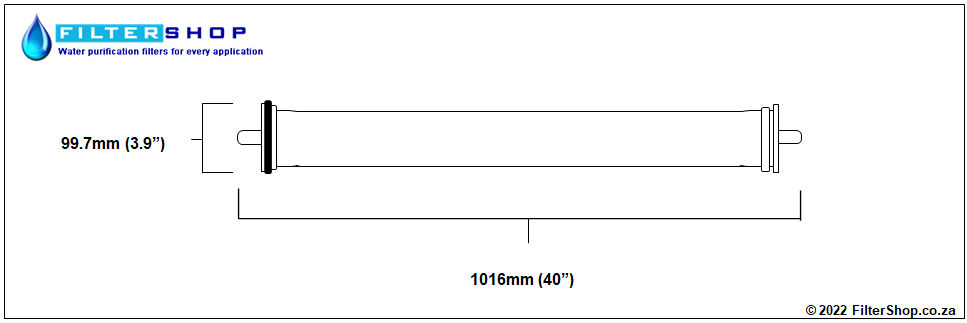4040 "Brackish Water" RO Membrane
The Reverse Osmosis (RO) Membrane forms the heart of a Reverse Osmosis System. It consists of a semi-permeable membrane that allows water molecules to pass through but captures 99.8% of all other particles in the water. The RO Membrane removes bacteria, viruses, minerals, heavy metals, and pesticides from the water.
The 4040 Brackish Water RO Membranes are meant for the desalination of brackish (salty) water with high TDS / Mineral content. These membranes are characterized by low-pressure operation, high water productivity, and excellent desalting performance. Designed to work with medium to large size commercial or industrial applications, such as boilers, Laboratories, Hospitals, Battery water, aquariums, foodstuff processing, pharmaceutical production, etc. The 4040 Brackish Water membranes are rated to handle source waters that have a TDS of 10 000ppm or lower (<10 000ppm).
4040 RO Membrane Specifications:

- Average Permeated Flow (Product Water): 3000GPD / 11 400LPD*
- Stable Rejection Rate: 99.3%
- Minimum Rejection Rate: 99%
Testing Conditions for Specification rating:
Testing Pressure: 225psi (15 bar)
Testing Solution Temperature: 25°C
Testing Solution Concentration (NaCl) - 2000ppm
PH Value of Testing Solution: 6.5 - 8.5
Recovery Rate of Single Element: 15%
Keep in Mind
The average permeated (product) water flow is based on test water consisting of 2000ppm of only salt (NaCl) which is one of the easier minerals for the RO membrane to handle. Other elements such as hardness (lime, Calcium/Magnesium) are harder for the membranes to remove, and may reduce the average permeate rate of the RO membrane.
Other elements such as source water pressure and the Total Dissolved Solids (TDS / Total Mineral Content) level can also have an influence on the permeate level produced by the membrane. Typically in real-world situations with municipal or non-municipal source water quality, you will not get the same quality and/or pressure as the "testing conditions" used to rate the membranes. So, in most applications, you will likely find that the actual permeate flow rate of the RO membrane is between 30 to 80% of what has been rated.
Operating Limits for the membrane:
Maximum Operating Temperature: 113°F (45°C)
Maximum Operating Pressure: 600 PSI (41 bar)
Maximum Feed Flow Rate: 16 GPM (3.6 m3/h)
pH Range, Continuous Operation: 3 – 10
pH Range, Short-Term Cleaning: (30 min.)b 2 – 12
Maximum Feed Silt Density Index (SDI): 5
Free Chlorine Tolerance: < 0.1 ppm
























































